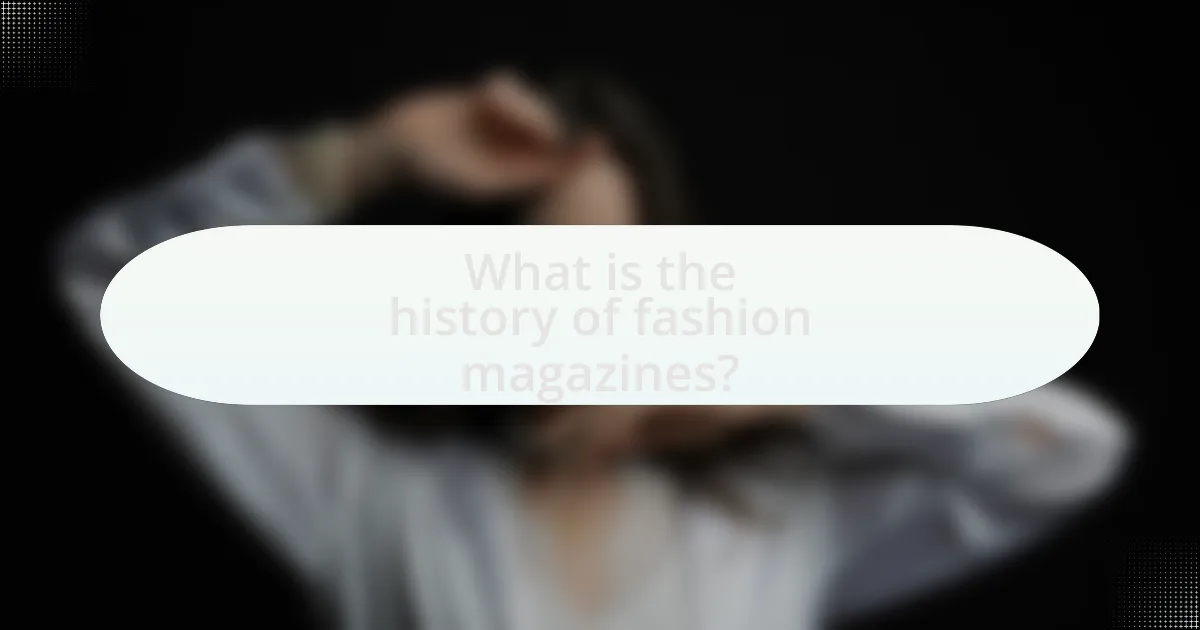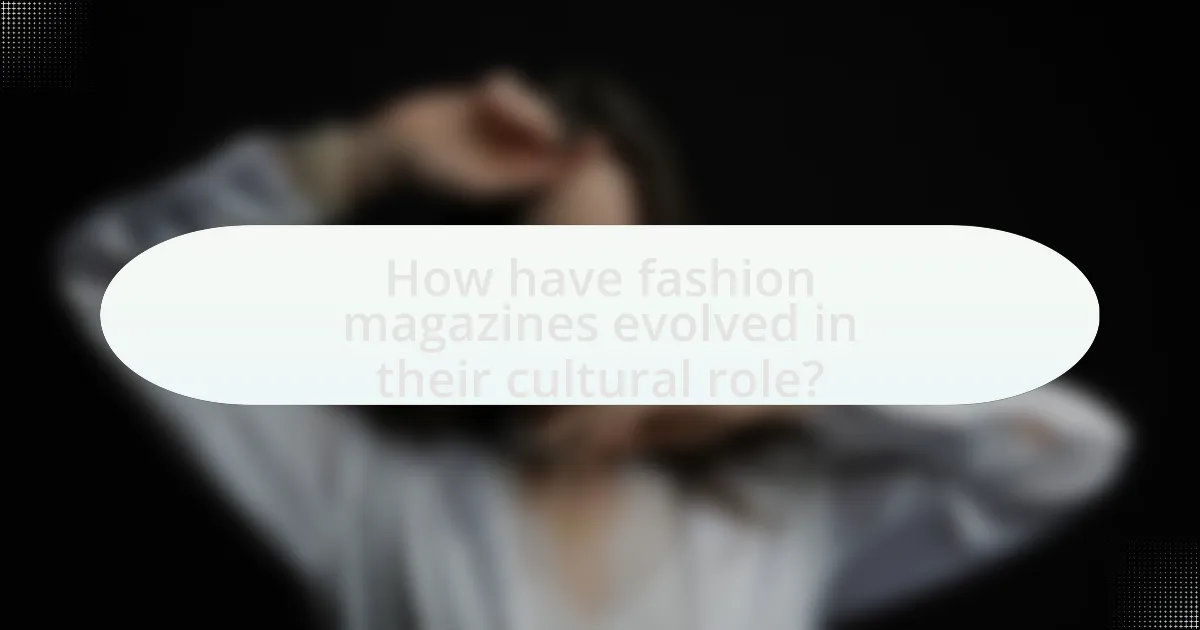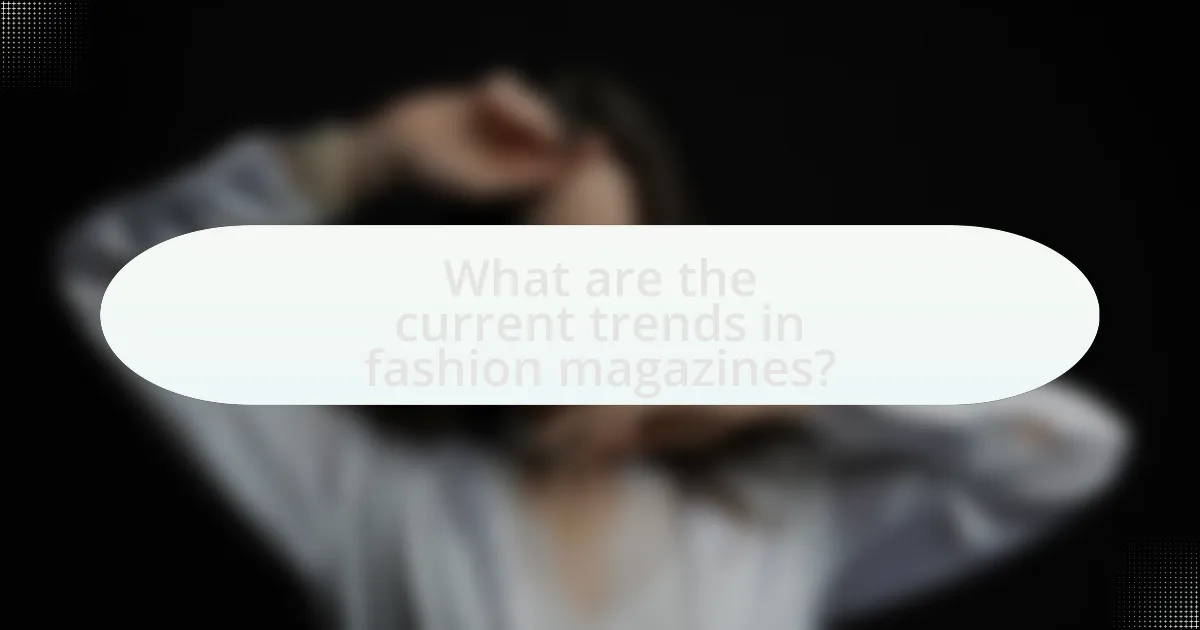The article examines the history of fashion magazines and their evolving cultural role from the 18th century to the present. It traces the origins of fashion publications, starting with “Le Mercure Galant” in France, and highlights significant developments such as the introduction of photography, the rise of celebrity culture, and the shift to digital platforms. The article discusses how fashion magazines have influenced societal norms, consumer behavior, and trends, while also addressing contemporary issues like sustainability and diversity. Key challenges faced by the industry in the digital age and strategies for engaging younger audiences are also explored, providing a comprehensive overview of the impact and significance of fashion magazines throughout history.

What is the history of fashion magazines?
The history of fashion magazines began in the 18th century with the publication of “Le Mercure Galant” in France, which featured fashion illustrations and articles. This magazine set the foundation for the genre by combining visual and textual content focused on clothing and style. In the 19th century, the rise of mass production and the industrial revolution led to the establishment of more specialized fashion publications, such as “Harper’s Bazaar” in 1867 and “Vogue” in 1892, which catered to a growing audience interested in fashion trends. These magazines not only showcased the latest styles but also influenced societal norms and consumer behavior, establishing themselves as key players in the fashion industry. By the 20th century, fashion magazines became essential platforms for designers and brands, shaping public perception and cultural identity through their editorial choices and advertising strategies.
How did fashion magazines originate?
Fashion magazines originated in the early 18th century, with the first notable publication being “Le Mercure Galant” in France, launched in 1672. This magazine featured articles on fashion, lifestyle, and culture, setting the foundation for future fashion publications. The rise of fashion magazines was further propelled by the Industrial Revolution, which increased the availability of printed materials and allowed for the mass production of magazines. By the 19th century, publications like “Harper’s Bazaar” and “Vogue” emerged, solidifying the role of fashion magazines in shaping public perceptions of style and trends. These magazines became influential platforms for designers and brands, reflecting and dictating fashion trends to a broader audience.
What were the first fashion magazines published?
The first fashion magazines published include “Le Mercure Galant,” which debuted in France in 1672, and “The Lady’s Magazine,” launched in England in 1770. “Le Mercure Galant” is recognized for its early focus on fashion trends and styles, while “The Lady’s Magazine” catered to women, featuring fashion alongside literature and advice. These publications laid the groundwork for the modern fashion magazine industry, influencing how fashion was presented and consumed.
How did early fashion magazines influence society?
Early fashion magazines significantly influenced society by shaping public perceptions of beauty, style, and social status. These publications, such as “Harper’s Bazaar” and “Vogue,” introduced new fashion trends and ideals, which were widely disseminated and adopted by readers. The magazines not only showcased the latest designs but also promoted a lifestyle associated with wealth and sophistication, thereby impacting consumer behavior and aspirations. For instance, the rise of the ready-to-wear industry in the late 19th century was fueled by the visibility and accessibility provided by these magazines, allowing a broader audience to engage with fashion. This democratization of style contributed to changing gender roles and the emergence of modern consumer culture, as women began to assert their identities through fashion choices influenced by magazine content.
What major developments occurred in fashion magazines over time?
Fashion magazines have evolved significantly over time, marked by key developments such as the introduction of color printing in the 1930s, the rise of celebrity culture in the 1980s, and the shift to digital platforms in the 2000s. The introduction of color printing allowed for more vibrant and appealing visuals, enhancing the reader’s experience and attracting a broader audience. In the 1980s, magazines began to feature celebrities prominently, which transformed the industry by linking fashion with popular culture and increasing readership. The transition to digital platforms in the 2000s revolutionized accessibility and interactivity, allowing magazines to reach global audiences instantly and engage readers through social media and online content. These developments reflect the changing dynamics of fashion, culture, and technology, illustrating the magazine’s role as a cultural influencer.
How did the introduction of photography change fashion magazines?
The introduction of photography revolutionized fashion magazines by enabling the visual representation of clothing and styles in a more realistic and engaging manner. Prior to photography, fashion illustrations dominated, which often lacked the detail and authenticity that photographs could provide. The first fashion magazine to utilize photography was “Harper’s Bazaar” in 1867, showcasing actual garments worn by models, which allowed readers to see how clothing looked in real life. This shift not only enhanced the appeal of fashion magazines but also influenced consumer behavior, as readers could better envision themselves in the featured styles, leading to increased sales and a more significant cultural impact on fashion trends.
What role did fashion magazines play during different historical periods?
Fashion magazines have served as influential cultural artifacts throughout various historical periods, shaping societal norms and trends. In the 19th century, they primarily functioned as platforms for disseminating fashion trends among the elite, reinforcing class distinctions and promoting consumerism. By the early 20th century, magazines like Vogue and Harper’s Bazaar began to democratize fashion, making it accessible to a broader audience and reflecting changing gender roles, particularly as women gained more independence. During the post-World War II era, fashion magazines played a crucial role in the rise of youth culture and the counterculture movement, showcasing diverse styles and challenging traditional norms. In the late 20th and early 21st centuries, they adapted to digital platforms, influencing global fashion trends and fostering a more inclusive representation of beauty and identity. This evolution illustrates how fashion magazines have not only mirrored but also shaped cultural and social dynamics across different historical contexts.

How have fashion magazines evolved in their cultural role?
Fashion magazines have evolved from mere promotional tools for clothing to influential cultural artifacts that shape societal norms and values. Initially, these publications primarily focused on showcasing garments and trends, catering to a niche audience of affluent consumers. Over time, they began to incorporate broader themes such as body positivity, diversity, and sustainability, reflecting changing societal attitudes. For instance, the rise of publications like Vogue and Harper’s Bazaar in the early 20th century marked a shift towards lifestyle and identity, while the introduction of digital platforms has further democratized fashion discourse, allowing for a wider range of voices and perspectives. This evolution illustrates how fashion magazines have transitioned into platforms for cultural commentary, influencing public perception and contributing to discussions on gender, race, and environmental issues.
What impact do fashion magazines have on cultural trends?
Fashion magazines significantly influence cultural trends by shaping public perceptions of beauty, style, and identity. They serve as platforms for showcasing emerging designers and trends, often dictating what is considered fashionable. For instance, the rise of streetwear in the late 2010s was propelled by magazines highlighting urban fashion, which in turn affected consumer behavior and retail strategies. Additionally, fashion magazines often reflect and amplify societal changes, such as the increasing demand for diversity and inclusivity in fashion, as seen in publications that feature models of various ethnicities and body types. This interplay between fashion magazines and cultural trends demonstrates their role as both trendsetters and mirrors of societal values.
How do fashion magazines shape public perceptions of beauty?
Fashion magazines shape public perceptions of beauty by consistently promoting specific beauty standards through curated imagery and editorial content. These publications often feature models who embody idealized physical traits, influencing societal norms regarding attractiveness. For instance, a study published in the journal “Body Image” found that exposure to fashion magazine images correlates with increased body dissatisfaction among women, highlighting the magazines’ role in establishing and reinforcing narrow definitions of beauty. Additionally, the prevalence of digitally altered images in these magazines further skews public perceptions, leading to unrealistic expectations about appearance.
What influence do fashion magazines have on consumer behavior?
Fashion magazines significantly influence consumer behavior by shaping trends, preferences, and purchasing decisions. They serve as a primary source of inspiration, showcasing the latest styles and brands, which can lead to increased consumer interest and demand. Research indicates that 70% of consumers are influenced by fashion magazines when making clothing purchases, highlighting their role in driving sales and brand awareness. Additionally, fashion magazines often feature endorsements from celebrities and influencers, further impacting consumer choices and reinforcing brand loyalty.
How do fashion magazines reflect societal changes?
Fashion magazines reflect societal changes by showcasing evolving trends, values, and cultural norms. For instance, the shift towards body positivity in the 2010s led magazines to feature diverse body types and promote inclusivity, as seen in publications like Vogue and Elle. This change mirrors broader societal movements advocating for acceptance and representation, highlighting how fashion media adapts to and influences public perception. Additionally, the rise of sustainable fashion in recent years has prompted magazines to prioritize eco-friendly brands and ethical practices, reflecting growing environmental awareness among consumers.
In what ways have fashion magazines addressed issues of diversity and inclusion?
Fashion magazines have addressed issues of diversity and inclusion by featuring a broader range of models representing various ethnicities, body types, and gender identities. For instance, publications like Vogue and Harper’s Bazaar have increasingly included models of color and plus-size models in their editorial spreads and cover stories, reflecting a more inclusive representation of beauty. Additionally, fashion magazines have published articles and editorials that discuss social justice issues, such as the Black Lives Matter movement, and have collaborated with diverse designers to promote inclusivity in the fashion industry. This shift is evidenced by the rise of initiatives like the #BlackAndFashion campaign, which calls for greater representation and equity within the fashion community.
How have fashion magazines adapted to the rise of digital media?
Fashion magazines have adapted to the rise of digital media by transitioning to online platforms, enhancing interactivity, and utilizing social media for broader engagement. This shift includes the development of digital editions, which often feature multimedia content such as videos and interactive graphics, allowing for a more immersive reader experience. Additionally, fashion magazines have embraced social media channels like Instagram and TikTok to reach younger audiences, leveraging influencers and user-generated content to maintain relevance in a rapidly changing landscape. According to a 2021 report by the American Association of Publishers, digital magazine subscriptions have increased by 20% over the past five years, indicating a successful adaptation to digital formats.

What are the current trends in fashion magazines?
Current trends in fashion magazines include a strong emphasis on sustainability, inclusivity, and digital engagement. Fashion magazines are increasingly featuring eco-friendly brands and sustainable practices, reflecting a growing consumer demand for environmentally conscious fashion. Additionally, there is a notable shift towards inclusivity, with magazines showcasing diverse models and promoting body positivity, which aligns with broader societal movements for representation. Furthermore, the rise of digital platforms has led to interactive content, such as augmented reality features and social media integration, allowing readers to engage with fashion in innovative ways. These trends are supported by industry reports indicating that sustainability and inclusivity are now key factors influencing consumer purchasing decisions in the fashion sector.
How are fashion magazines responding to the digital age?
Fashion magazines are adapting to the digital age by enhancing their online presence and integrating multimedia content. They are shifting from traditional print formats to digital platforms, utilizing social media, websites, and mobile applications to reach a broader audience. For instance, major publications like Vogue and Harper’s Bazaar have developed interactive features, such as video content and augmented reality experiences, to engage readers more effectively. Additionally, the rise of influencer culture has led fashion magazines to collaborate with social media influencers, thereby expanding their reach and relevance in a rapidly evolving digital landscape. This transition is evidenced by the significant increase in digital subscriptions and online readership, which have become crucial for sustaining their business models in the face of declining print sales.
What new formats are emerging in fashion magazines today?
New formats emerging in fashion magazines today include digital-first publications, interactive content, and augmented reality features. Digital-first publications prioritize online platforms, allowing for real-time updates and multimedia integration, which enhances reader engagement. Interactive content, such as shoppable articles and quizzes, encourages reader participation and personalization. Augmented reality features enable readers to visualize clothing in 3D or try on outfits virtually, creating an immersive experience. These innovations reflect the industry’s adaptation to technological advancements and changing consumer preferences, as evidenced by the rise of platforms like Vogue Runway and the increasing use of AR in brands like Gucci.
How do social media platforms influence fashion magazine content?
Social media platforms significantly influence fashion magazine content by shaping trends, audience engagement, and content distribution. These platforms allow fashion magazines to quickly gauge public interest and adapt their editorial choices accordingly, often prioritizing visually-driven content that resonates with social media users. For instance, platforms like Instagram and TikTok have led to the rise of influencer culture, prompting magazines to feature influencers prominently in their articles and campaigns, as seen in the increased collaborations between brands and social media personalities. Additionally, analytics from social media provide magazines with insights into reader preferences, enabling them to tailor their content to align with current trends and audience demands. This shift has resulted in a more dynamic and interactive relationship between fashion magazines and their readership, reflecting the immediate feedback loop created by social media engagement.
What challenges do fashion magazines face in the modern era?
Fashion magazines face significant challenges in the modern era, primarily due to the rise of digital media and changing consumer behaviors. The shift from print to online platforms has led to declining circulation and advertising revenues for traditional magazines, with a reported 20% drop in print advertising revenue from 2017 to 2020. Additionally, fashion magazines struggle to maintain relevance in a landscape dominated by social media influencers and fast fashion brands, which often provide immediate and accessible content that appeals to younger audiences. This competition has forced magazines to adapt their content strategies, focusing more on digital engagement and social media presence to attract readers.
How are fashion magazines addressing sustainability issues?
Fashion magazines are addressing sustainability issues by featuring eco-friendly brands, promoting sustainable fashion practices, and highlighting the importance of ethical consumption. For instance, publications like Vogue and Elle have dedicated sections that focus on sustainable fashion, showcasing designers who prioritize environmentally friendly materials and production methods. Additionally, these magazines often publish articles that educate readers on the impact of fast fashion and encourage a shift towards more sustainable choices, thereby influencing consumer behavior and industry standards.
What strategies are fashion magazines using to engage younger audiences?
Fashion magazines are utilizing digital platforms and social media engagement to attract younger audiences. By leveraging Instagram, TikTok, and other social media channels, these magazines create visually appealing content that resonates with the aesthetic preferences of younger demographics. For instance, Vogue and Elle have adopted influencer partnerships and user-generated content campaigns, which have proven effective in increasing their reach and engagement among millennials and Gen Z. According to a 2022 study by the Pew Research Center, 71% of young adults use social media to discover new fashion trends, highlighting the importance of these strategies in connecting with this audience.
What best practices can be applied to fashion magazine publishing?
Best practices in fashion magazine publishing include maintaining a strong editorial vision, leveraging high-quality visuals, and engaging with the audience through digital platforms. A clear editorial vision ensures consistency in content and brand identity, which is crucial for attracting and retaining readers. High-quality visuals are essential in fashion publishing, as they significantly impact reader engagement; studies show that articles with compelling images receive 94% more views. Additionally, utilizing digital platforms for audience engagement, such as social media and interactive content, enhances reader connection and expands reach, reflecting the shift in consumer behavior towards online consumption.

Leave a Reply